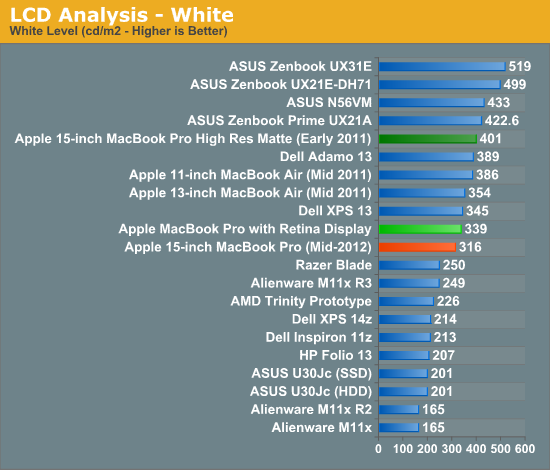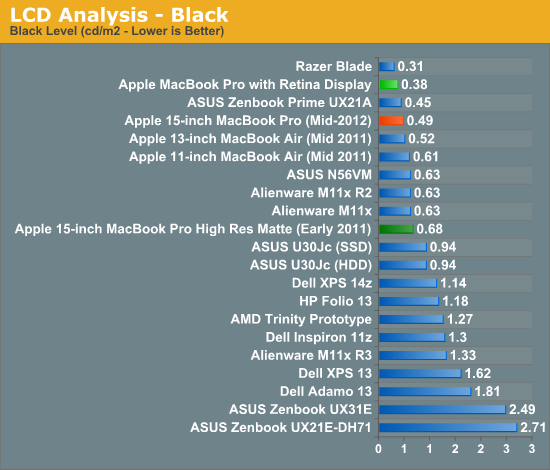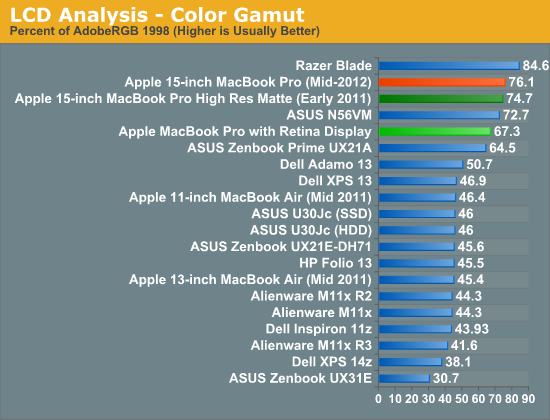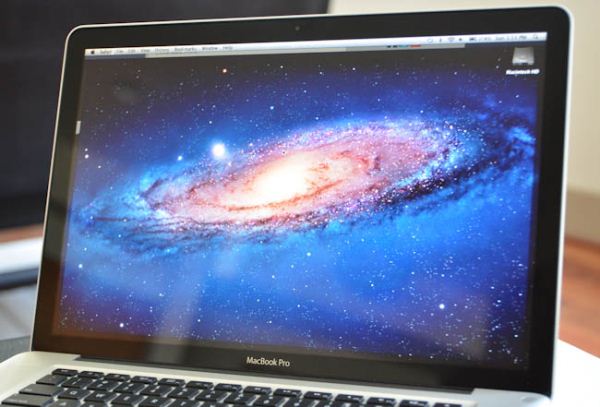The 2012 MacBook Pro Review
by Vivek Gowri on July 18, 2012 2:00 PM EST- Posted in
- Mac
- Apple
- MacBook Pro
- Laptops
- Notebooks
The story about the regular MacBook Pro's display is more about what it isn't (game changing) because we already know what it is (very competent). As always, the display is a very high quality one, essentially the same as the previous 3 years of MacBook Pros and testing very similarly to the other 15" MacBook Pros we've reviewed over the last few years. Our evaluation unit had the base 1440x900 display, though I'd have preferred the matte WSXGA+ panel. The higher resolution is nice to have, and with the matte screen finish, it was one of my absolute favourite notebook displays.




In terms of display performance, the 2012 MBP matches up very close to the 2011 and 2010 models, with very good contrast ratio and colour reproduction. But that’s the thing with the regular 2012 MBP – it’s just like the 2011 and 2010 MBPs, just updated to IVB/Kepler.
The real story here is about what you’re giving up. After using an rMBP, it's actually a little bit difficult to go back to a normal MBP display. I mean, this is by far the biggest differentiating factor between the two, and if you’re looking for a solid reason to put the money down for a Retina, this is it. The normal MBP has a good display, a very good display if you go for the matte high-res option, but the Retina MBP display is just on a completely different level. Like the new iPad, the resolution difference doesn’t add to the screen real estate so much as allowing for a vastly improved UX with higher resolution UI elements and better text rendering. It’s difficult to quantify, and it’s easy to dismiss on the surface, but when you actually use a super high-res panel for a prolonged amount of time, you understand the difference it makes. Obviously, there are still some bugs, and it’ll take probably one full development cycle for most applications to be updated to Retina-spec textures and UI elements, but that is all to be expected in a radical shift such as this. If you’re comfortable sticking to the tried-and-true MBP display, it’s not a bad way to go, but I’d advise you to use a Retina MBP before making a decision to go one way or the other.











132 Comments
View All Comments
Sunburn74 - Thursday, July 19, 2012 - link
What? you have to buy something in order to be able to rightfully criticize it these days?stimudent - Friday, July 20, 2012 - link
Another overpriced Apple product.stimudent - Friday, July 20, 2012 - link
Anything that gives us an alternative to Windows is a good thing. Now if only we could get away from Intel chips.Hendrix248 - Saturday, July 21, 2012 - link
Never heard of Linux? Why would you want to move away from the best chips on the market?Belard - Wednesday, July 18, 2012 - link
As another has posted, its a standard design.... and it is a bit expensive. A ThinkPad T500 with the same specs that comes out of the same FOXCONN company sells for several hundred dollars less.okay, where is the full review on the Motorola Atrix HD?!
Belard - Wednesday, July 18, 2012 - link
By the way... a physical Ethernet port is still very handy for those times when you cannot get WIFI... there are some hotels/motels who are still wired. Or if you are at a location or family place where the WIFI fails or they lose the WiFi Password.Or you are at a clients place and need quick access and they don't want to give your wifi access.
inplainview - Thursday, July 19, 2012 - link
It has Ethernet over Thunderbolt....Hendrix248 - Saturday, July 21, 2012 - link
After you buy the adapter...Grok42 - Sunday, July 22, 2012 - link
Wi-Fi is great for quickly connecting to the Internet and other casual usage but I think apple has really underestimated the need for a wired connection, at least with current Wi-Fi tech. The problem with Wi-Fi is that it has a MUCH higher latency than a wired connection. This is important for voice, video or remotely viewing desktops. Wi-Fi is also very prone to dropping connections if for only a split second. You would never notice when browsing the web as the connection is stateless. However, if you use any networking services that won't survive a dropped connection it can be frustrating. These services include copying files, SSH, RDP, VNC, etc.Probably the biggest need for Ethernet is when dealing with large files. I can transfer a 15GB file from our servers in a few seconds with a gigabit Ethernet port. I have had it take hours to copy the same file over Wi-Fi. That is unless the signal drops at which point you will want to throw things when you have to start over again.
It seems that Apple or someone should be working on standardizing a slimmer version of the RJ-45 connector. Dongles go against everything Apple stands for on the design side.
sandro - Tuesday, July 24, 2012 - link
This is something I have been wondering since some time. What is in the way of standardizing a slimmer RJ-45 connector? Adapters would be so inexpensive that they could be included with the product. I wonder why Apple went this way instead of making a thunderbolt to ethernet dongle, which by construction costs quite some money and takes away one (to become) precious port.